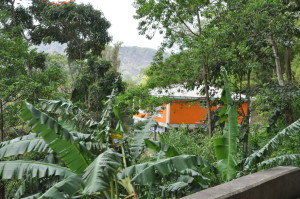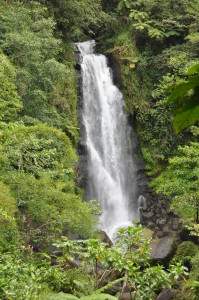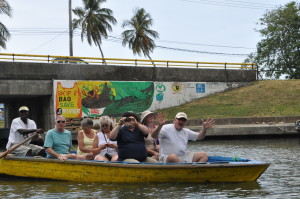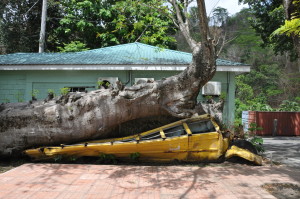Third in a Series:
It was a tale of shipboard adventure and romance played out on the high seas.
Well, that may be a bit dramatic. But when one of our fellow shipmates fell onto another passenger while standing on deck during a rocking and rolling nighttime voyage between the islands of St. Lucia and Dominica on our recent Island Windjammers French West Indies Cruise, her husband gallantly came to the rescue and promptly fell onto the anchor chain.
The result: one broken wrist (wife), one badly sprained finger (husband).
Both remained good-humored throughout the trip, sling and bandaging notwithstanding. In fact, they were two of the most upbeat folks on board, and I heard not a complaint from either.
The sheer pleasure of being on a windjammer on tropical seas can turn even what appeared to be painful injuries into punch lines (the husband in question is a gifted natural comedian, who had everyone in stitches — figuratively speaking — throughout the week).
Captain Matt, for his part, had earlier given us a stern lecture about safety aboard the Sagitta, our 24-passenger motor-sailing vessel, covering every contingency he could think of — but ship happens, as they say. Especially when the waves are high and the night is dark.
This was our only truly rough crossing of the trip, and the Captain had thoughtfully moved dinner up to 6 p.m. (from the normal 7) so that we wouldn’t be dining during the turbulence.
By the time we reached Dominica the next morning, the rough seas had calmed, everyone had more or less recovered, and we were ready to tour the island called “the Caribbean’s Garden Isle.”
Yes, it may be the Dominica tourism board that calls it that, but it’s a deserving title. Dominica — not to be confused with the much larger Dominican Republic to the north — is lush, seems to grow every kind of tropical fruit imaginable, and its mountains are thickly forested.
It’s best known as an eco-tourism destination. Forty percent of the island is national parkland, and the country has rejected entreaties from certain Asian countries to trade fishing rights for development aid, the better to preserve their natural resources.
Dominica is also the site of the last large (3,000-person) settlement of Carib Indians, who occupied and ruled the area until the arrival of Columbus; European diseases and forced hard labor killed most of the natives off throughout the Caribbean as the Spanish and other European powers took over the region. Most Caribs live in the northeastern part of the island.
One thing Dominica has very few of: beaches. So not that many visitors go there, which is a shame.
During our day on the island, we climbed steep, twisting roads up the mountains, offering panoramic views of valleys and hillsides dotted with brightly colored houses; swam through a narrow, steep-walled and light-speckled gorge to reach a waterfall on the other end; soaked in hot springs warmed by percolating geothermal waters below; and hiked to cascades pouring down into mountain pools.
Back in Roseau, the capital, where the boat’s dinghy had let us off, we stopped at a botanical garden to view giant baobab and banyan trees, one of which had fallen on a school bus during a disastrous 1979 hurricane (the bus, which was unoccupied at the time, still lay there, completely crushed by the weight of the tree); had lunch at a local place where women grilled chicken outdoors and a man fixed fried fish indoors; and, down the road a ways, snorkeled along a reef off a rocky beach.
The lunch was delicious and incredibly cheap, and the music was loud with an infectious beat. One of our group started to dance and, after everyone had eaten their fill and washed it down with local beer, a number of others joined in with her, gyrating to the music in front of the little eatery, as passing drivers did double-takes at seeing tourists in funny sunhats getting their groove on.
It was one of those spontaneous moments — like jumping into the water off the ship the previous day — that bonds groups together and makes small ship cruising a special experience.
The next day the ship anchored off the northern end of the island, near the town of Portsmouth, and we saw a different side of Dominica. There was a black sand beach, not very inviting, so my wife, Catharine, and I hiked up to a fort on a hillside overlooking the harbor.
The 18th-century-era British fort had been painstakingly restored by the delightfully named Lennox Honeychurch, a native of the island, and came complete with cannons that were intended for the dreaded French, who were then eyeing the British stronghold of Jamaica — but no shot was ever fired. However, judging by the pictures on the walls, the British officers there had a jolly good time being served cool drinks by enslaved Africans, themselves made to dress in very un-tropical ruffles and flourishes.
Various trails led up to the ruins of the Commandant’s house as well as a one-time lookout that had a spectacular view of the water far below with a sheer drop-off and no guard rail — a selfie disaster waiting to happen.
Our afternoon was spent on a peaceful rowboat tour of one of Dominica’s 365 rivers — one for each day of the year — or so the tourist literature says. (It seems a little too convenient, but then, I haven’t counted them.) Our boat was paddled by a local guide, who explained that the river was one setting for the movie Pirates of the Caribbean 2, which was filmed largely in Dominica.
We passed a ramshackle house that had been built for the movie, as well as some skulls and one too many skeletons dangling from trees. But the trees were authentic, as was a heron we happened upon who was intently stalking his prey and looked annoyed at us for interrupting his stealth shtick.
The day was complete after a barbecue on the beach, when Captain Matt joined in the rib-grilling, while the music at the little restaurant (The Purple Turtle) where we sat blasted the Mozart lovers out of their seats. The music volume seemed to be one of the few things during the week that divided the baby boomers among us (who left on the early side) from the younger generations, who probably stayed for hours.
As a baby boomer myself, I was long since in bed, ready to greet the sunrise on deck.
Up next: the idyllic Iles des Saintes, Guadeloupe.
For more information on Island Windjammers and Dominica, go to:
Dominica Hotel & Tourism Association
For previous posts in this series, go to:
Island Time: Life on an Island Windjammers Cruise
Seeking the Sagitta and Seafood on St. Lucia
Readers: You can subscribe to my blog and get notification of every post by simply typing in your email address and clicking on the blue Subscribe button or downloading my free report, How to Ride the Coming Wave of Boomers.Thanks!
















2 Responses to An Island Windjammers Tour of Dominica